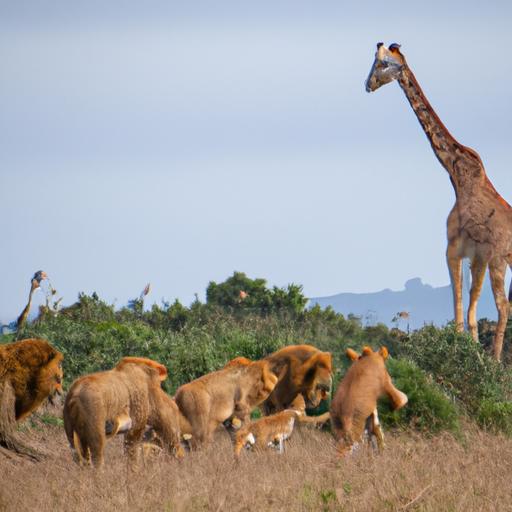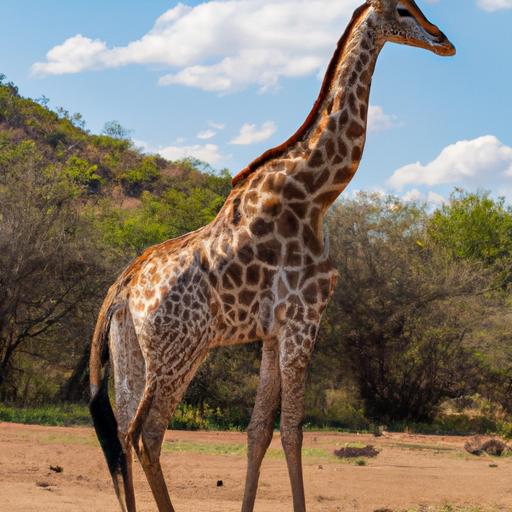Giraffes, those awe-inspiring creatures with their long necks and graceful demeanors, have always captivated our imagination. But have you ever wondered what lurks in the shadows, ready to pounce on these gentle giants? In this article, we embark on a journey to explore the predator-prey relationship and uncover the answer to the age-old question: what eats giraffes?
Introduction
As we delve into the world of giraffes and their predators, let’s first appreciate the sheer magnificence of these majestic animals. With their towering height, elegant strides, and striking coat patterns, giraffes are a sight to behold. But beyond their aesthetic appeal, understanding the predator-prey relationship is vital for the survival of both species.
The intricate interplay between predators and prey is a fundamental aspect of the natural world. Giraffes, being at the top of the food chain, have their fair share of predators. By unraveling the mysteries of what eats giraffes, we gain insights into the delicate balance that exists within ecosystems.
Why is it important to comprehend this predator-prey dynamic? Well, imagine a world where we only focus on the beauty and grandeur of giraffes, neglecting to acknowledge the threats they face. By understanding the predators that hunt giraffes, we can take necessary steps to conserve and protect these magnificent creatures.
So, join me on this enthralling expedition as we explore the depths of the savannah, where predators lurk and prey roam. Together, we will uncover the secrets of what eats giraffes, unearthing the intricate tapestry woven by nature itself. Get ready to be amazed, because the wilderness has much in store for us!
Giraffes in their Natural Habitat
Description of Giraffes’ Natural Habitat and Range
Giraffes are native to the vast landscapes of Africa, where they inhabit various habitats across the continent. From the open savannahs of East Africa to the dense woodlands of West Africa, giraffes have adapted to thrive in diverse environments. These gentle giants can be found in countries like Kenya, Tanzania, South Africa, and Namibia, among others.
Their natural habitat consists of expansive grasslands, acacia woodlands, and even semi-arid regions. Giraffes’ range extends across different ecosystems, allowing them to access the necessary resources for survival. This adaptability is a testament to their resilience and ability to carve a niche in various landscapes.
Characteristics and Adaptations of Giraffes for Survival
Giraffes possess a unique set of characteristics and adaptations that enable them to survive and thrive in their natural habitat. Their most striking feature, the long neck, allows them to browse on leaves, twigs, and even fruits from tall trees that many other herbivores cannot reach. This gives them a competitive advantage in finding food and utilizing resources.
In addition to their long necks, giraffes have powerful muscular tongues and lips, which they use to strip leaves from branches. Their tongues, reaching up to 20 inches in length, are tough and dexterous, perfectly suited for maneuvering through thorny vegetation while minimizing injuries.
Another remarkable adaptation is their high vantage point. Giraffes’ height provides them with an excellent view of their surroundings, enabling them to detect predators from a distance. Their large, expressive eyes and keen senses further enhance their ability to remain vigilant in the face of danger.
By understanding giraffes’ natural habitat and the adaptations that help them survive, we can gain a deeper appreciation for these magnificent creatures. In the next section, we will explore the predators that pose a threat to giraffes, unraveling the secrets of what eats these towering herbivores. Get ready for an adventure into the world of giraffe predators!
Predators of Giraffes
Introduction to the Concept of Giraffe Predators
In the vast expanse of the wild, giraffes are not exempt from the ever-present threat of predators. Their towering height and powerful kicks may seem like a formidable defense, but there are creatures that have adapted to take on these gentle giants. Understanding the concept of giraffe predators is essential to comprehend the complex dynamics of the predator-prey relationship.
Natural Predators in the Wild
When we think of predators, the majestic lion immediately comes to mind. Lions are the primary predators of giraffes, known for their unparalleled strength and strategic hunting techniques. These magnificent felines possess the power and agility to bring down even the tallest of giraffes.
However, lions are not the only carnivores that target giraffes. Other predators, such as hyenas and leopards, also pose a threat. Hyenas, with their pack mentality and relentless pursuit, can overpower a lone giraffe. Leopards, on the other hand, rely on stealth and camouflage to ambush their prey, including unsuspecting giraffes.
Factors Influencing the Choice of Giraffe Prey
But why do these predators choose giraffes as their prey? Several factors influence this choice. The first factor is accessibility. Giraffes, with their long necks and towering presence, may seem like an easy target for predators. Their size and visibility make them a desirable meal for those willing to take on the challenge.
Another factor is the nutritional value that giraffes offer as prey. Giraffes provide a substantial amount of meat, allowing predators to satisfy their hunger with a single kill. Additionally, giraffes’ large size ensures that predators can feed on them for an extended period, reducing the need for frequent hunts.
As we continue our exploration, we will uncover more fascinating insights into the hunting techniques employed by these predators and the strategies giraffes employ to defend themselves against their formidable foes. Stay tuned as we unravel the secrets of the wild and shed light on the captivating world of what eats giraffes.
Hunting Techniques of Giraffe Predators
Giraffe predators have evolved remarkable hunting techniques to bring down these towering herbivores. Let’s dive into the fascinating world of their strategies and tactics.
Lion Hunting Strategies
Lions, the kings of the jungle, are among the primary predators of giraffes. These majestic felines rely on their strength, agility, and cunning to successfully hunt these mighty creatures. It’s a game of strategy and teamwork for lions.
When targeting a giraffe, lions often work together in a coordinated effort. They strategize and plan their attack, utilizing their exceptional teamwork skills. By surrounding their prey, they create a sense of panic and confusion, making it difficult for the giraffe to escape. The coordinated efforts of a lion pride increase their chances of a successful hunt.
Collaboration Among Predators
While lions are formidable predators, they are not the only ones eyeing the giraffes. In some cases, different predators collaborate to increase their chances of a successful hunt. For instance, a group of lions may join forces with hyenas or African wild dogs to take down a giraffe. This collaboration allows them to combine their strengths and tackle the challenges posed by such a large and powerful prey.
Stealth and Ambush Techniques
Predatory species like leopards and cheetahs have mastered the art of stealth and ambush. These solitary hunters rely on their exceptional camouflage and lightning-fast speed to surprise their prey. When hunting giraffes, they patiently stalk their target, meticulously observing their movements and waiting for the perfect moment to strike. With lightning-quick bursts of speed, they close in on their unsuspecting prey, overwhelming them with their agility and precise techniques.
The hunting techniques of giraffe predators are a testament to nature’s ingenuity. From the strategic planning of lion prides to the solitary stealth of leopards and cheetahs, each predator has honed their skills to adapt to the challenges posed by hunting such an imposing herbivore. Join me in the next section as we explore the delicate balance and survival strategies of giraffes in the face of these formidable hunters.
Giraffe Predation: A Balancing Act
Giraffes’ Defense Mechanisms against Predators
In the unforgiving world of the wild, giraffes have evolved remarkable defense mechanisms to fend off their predators. Their towering height alone acts as a deterrent, making it difficult for many predators to launch successful attacks. Additionally, giraffes possess powerful legs that can deliver devastating kicks, capable of warding off even the most persistent hunters.
But defense goes beyond physical attributes. Giraffes have developed a keen sense of awareness, constantly scanning their surroundings for potential threats. Their exceptional eyesight allows them to observe predators from afar, giving them ample time to react and escape. Furthermore, giraffes have an acute sense of hearing, allowing them to detect the faintest sounds of danger.
Impact of Predation on Giraffe Populations
While giraffes have formidable defenses, they are not completely invulnerable. Predation plays a significant role in shaping giraffe populations. The presence of predators acts as a natural selection pressure, favoring individuals with superior survival strategies. Giraffes that possess heightened vigilance and agility are more likely to survive and pass on their genes to future generations.
The impact of predation extends beyond individual survival. Giraffe populations are regulated by the predation pressure they experience. In areas with high predator densities, giraffe populations may be kept in check, preventing overpopulation and resource depletion. This delicate balance ensures the sustainability of both predator and prey species, allowing for a harmonious coexistence.
Role of Predation in Maintaining Ecosystem Balance
Predation serves a vital role in maintaining ecosystem balance. It acts as a control mechanism, preventing any one species from dominating the landscape. Without the presence of predators, herbivore populations, including giraffes, could surge uncontrollably, leading to overgrazing and habitat degradation. This, in turn, would have cascading effects on other plant and animal species within the ecosystem.
By regulating the population sizes of herbivores, predators indirectly contribute to the preservation of biodiversity. They create a dynamic equilibrium, where each species has a niche to fill and plays a crucial role in the intricate web of life. Giraffes, as both prey and grazers, hold a unique position in this delicate balance, showcasing the intricate dance of predator and prey.
As we marvel at the grace and beauty of giraffes, let us not forget the role predators play in their survival. Understanding the defense mechanisms of giraffes, the impact of predation on their populations, and the larger ecosystem balance they contribute to, we gain a profound appreciation for the intricate tapestry of life in the wild.
Section VI: Conclusion
After our captivating journey through the realms of giraffes and their predators, it is time to reflect on the knowledge we have acquired. The intricacies of the predator-prey relationship have been unveiled, shedding light on the question of what eats giraffes.
Throughout our exploration, we have come to appreciate the grandeur of giraffes as majestic creatures. Their towering height and graceful demeanor make them a true wonder of the animal kingdom. However, it is equally important to recognize the significance of understanding the predator-prey relationship.
By understanding the predators that hunt giraffes, we gain a deeper understanding of the delicate balance that exists within ecosystems. Lions, as primary predators of giraffes, play a crucial role in maintaining this balance. Other carnivores also contribute to the predator-prey dynamic, showcasing the complexity of nature’s web.
Giraffes, in their defense against predators, have developed remarkable adaptations. Their long necks not only aid in foraging but also serve as a lookout tower to detect potential threats. Their powerful legs and swift movements allow them to evade predators, showcasing their remarkable resilience.
The impact of predation on giraffe populations cannot be ignored. It is through this natural process that weaker individuals are weeded out, ensuring the survival of the fittest. This constant struggle for survival shapes ecosystems, maintaining a harmonious equilibrium.
As we conclude our journey, let us not forget the importance of preserving giraffe populations. By safeguarding their existence, we contribute to the overall health and balance of our planet’s ecosystems. The predator-prey relationship is a testament to the intricate web of life, reminding us of our responsibility to protect and conserve the natural world.
So, as we bid farewell to the wild savannahs and the enigmatic world of giraffes, let us carry with us the knowledge gained. May we continue to marvel at the wonders of nature and strive to be stewards of this fragile planet we call home. Together, we can ensure that the question of what eats giraffes remains a captivating mystery for generations to come.


